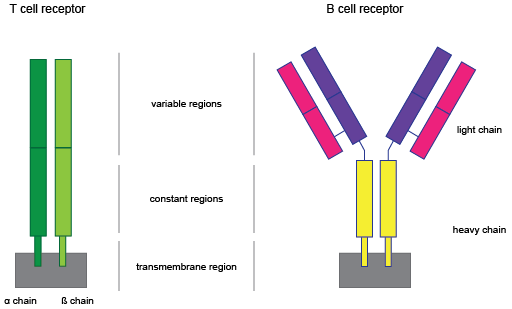Immune repertoire analysis

Figure 7.1: T and B cell receptors structure.
T and B cells form our acquired immune response. They both contain highly variable receptors (see figure 7.1) that recognize foreign antigens and consist of multiple chains. T cell receptors (TCR) consist of two chains, either an ![]() (TRA) and a
(TRA) and a ![]() (TRB) chain, or a
(TRB) chain, or a ![]() (TRG) and a
(TRG) and a ![]() (TRD) chain. B cell receptors (BCR) contain two light chains, and two heavy chains. There are two types of light chains in humans:
(TRD) chain. B cell receptors (BCR) contain two light chains, and two heavy chains. There are two types of light chains in humans: ![]() (IGK) and
(IGK) and ![]() (IGL), while other animals also contain other types of light chains. Once set, the light chain class remains fixed for the life of the B cell. There are five types of heavy chains (IGH) for mammals:
(IGL), while other animals also contain other types of light chains. Once set, the light chain class remains fixed for the life of the B cell. There are five types of heavy chains (IGH) for mammals: ![]() ,
, ![]() ,
, ![]() ,
, ![]() and
and ![]() , defining the class of the receptor.
, defining the class of the receptor.
The chains are encoded by genes that undergo somatic recombination. During this process, gene-segments are joined with random nucleotides at the junction sites. There are two types of recombination (see figure 7.2):
- VJ recombination, where one V (variable) gene-segment is joined to a J (joining) gene-segment;
- VDJ recombination, where a D (diversity) gene-segment is added between the V and J gene-segments.

Figure 7.2: VDJ recombination brings together a V, D, J and C gene-segment.
For both types of recombination, a C (constant) gene-segment is also added following the J segment.
The TRA and TRG chains are the result of VJ recombination, while the TRB and TRD chains are the result of VDJ recombination. The V, D, J and C gene-segments are specific for each TCR chain type.
BCR light chains are the result of VJ recombination, while BCR heavy chains are the result of VDJ recombination. BCR heavy chains have three to four C gene-segments. The V, D, J and C gene-segments are specific for each BCR light chain type, while they are shared by the BCR heavy chains.
The V and J segments contain a conserved cysteine (C) and phenylalanine/tryptophan (F/W) amino-acid, marking the beginning and end of the CDR3 (complementary-determining) region, respectively. Due to inclusion of random nucleotides at the junctions between segments, the CDR3 region is highly variable. The V segment contains two other highly variable regions: CDR1 and CDR2 (see figure 7.2).
Biomedical Genomics Analysis offers tools to clonotype reads and characterize the T or B cell receptor repertoire (Immune Repertoire Analysis), filter the repertoires (Filter Immune Repertoire) and compare them (Compare Immune Repertoires). Here, clonotyping a read consists of identifying which V, D, J and C segments from the reference data (see Immune Repertoire Analysis) are used, and extracting the CDR3 region found between the conserved amino acids.
Subsections
- Import/Export VDJtools Clonotypes
- Import Immune Reference Segments
- Immune Repertoire Analysis
- Filter Immune Repertoire
- Compare Immune Repertoires
- Clonotypes
- Clonotype Sample Comparison
